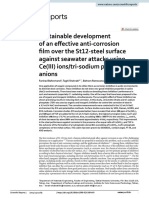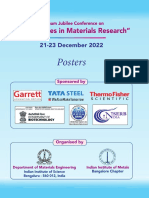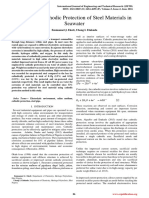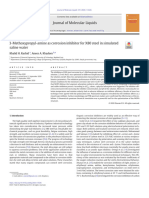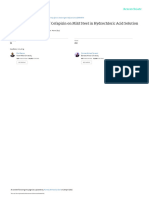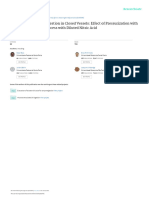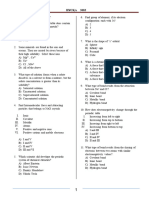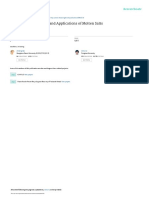Investigation of Inhibitive Action of Urea-Zn2 Sys
Investigation of Inhibitive Action of Urea-Zn2 Sys
Uploaded by
Douglas SantosCopyright:
Available Formats
Investigation of Inhibitive Action of Urea-Zn2 Sys
Investigation of Inhibitive Action of Urea-Zn2 Sys
Uploaded by
Douglas SantosOriginal Title
Copyright
Available Formats
Share this document
Did you find this document useful?
Is this content inappropriate?
Copyright:
Available Formats
Investigation of Inhibitive Action of Urea-Zn2 Sys
Investigation of Inhibitive Action of Urea-Zn2 Sys
Uploaded by
Douglas SantosCopyright:
Available Formats
See discussions, stats, and author profiles for this publication at: https://www.researchgate.
net/publication/267782937
Investigation of inhibitive action of urea-Zn2+ system in the corrosion
control of carbon steel in sea water
Article · November 2011
CITATIONS READS
13 8,176
2 authors:
Mani Manivannan Susai Rajendran
RVS College of Engineering and Technology
13 PUBLICATIONS 133 CITATIONS
468 PUBLICATIONS 2,204 CITATIONS
SEE PROFILE
SEE PROFILE
Some of the authors of this publication are also working on these related projects:
orthodontic wires corrosion in saliva View project
Nanosensors for smart agriculture View project
All content following this page was uploaded by Susai Rajendran on 28 July 2015.
The user has requested enhancement of the downloaded file.
M. Manivannan et al. / International Journal of Engineering Science and Technology (IJEST)
INVESTIGATION OF INHIBITIVE
ACTION OF UREA- ZN2+ SYSTEM IN
THE CORROSION CONTROL OF
CARBON STEEL IN SEA WATER
M. MANIVANNAN *1
1
Department of Chemistry, Chettinad College of Engineering and Technology,
Karur – 639 114, Tamil Nadu, India
Email: manichem76@gmail.com, Mobile: +91 9789739587
S. RAJENDRAN 2, 3
2
Corrosion Research Centre, GTN Arts College,
Dindigul – 624 005, Tamil Nadu, India
3
Department of Chemistry, RVS School of Engineering and Technology,
Dindigul – 624 005, Tamil Nadu, India
Abstract :
The inhibition efficiency (IE) of Urea in controlling corrosion of carbon steel in sea water in the absence and
presence of Zn2+ has been evaluated by weight loss method. The formulation consisting of 250 ppm urea and
50 ppm Zn2+ has 94% IE. It is found that the inhibition efficiency (IE) of urea increases by the addition of Zn2+
ion. A synergistic effect exists between urea and Zn2+. Polarization study reveals that Urea – Zn2+ system
controls the cathodic reaction predominantly and suggests the formation of protective film on the metal surface.
The nature of the protective film formed on the metal surface has been analyzed by FTIR spectra and AFM
analysis. The protective film is found to consist of Fe2+ – Urea complex and Zn(OH)2. Based on the above
studies a suitable mechanism has been proposed for the corrosion inhibition.
Keywords: Corrosion inhibition, Urea, carbon steel, synergistic effect, FTIR, AFM, sea water
1. Introduction
Corrosion is the deterioration of metals and alloys by electrochemical reaction with its environment. It is a
natural phenomenon which cannot be avoided, but it can be controlled and prevented using the suitable
preventive measures like metallic coating, anodic protection, cathodic protection and using inhibitors, etc.
Inhibitors are playing very good role in the process of corrosion control. The organic inhibitors containing
hetero atoms like oxygen, nitrogen, sulphur and phosphorus, etc shows better corrosion inhibition by forming
protective layer over the metal surface. Also the corrosion inhibition efficiency follows the order O < N < S < P
1-4
. Among various organic compounds, urea and its derivatives shows significant corrosion inhibition of metals
and alloys in corrosive media. As urea molecule (Fig. 1) contains one oxygen and two nitrogen atoms, hence
urea and its derivatives can act as very good corrosion inhibitors 5-7.
Fig. 1. Structure of urea
ISSN : 0975-5462 Vol. 3 No.11 November 2011 8048
M. Manivannan et al. / International Journal of Engineering Science and Technology (IJEST)
The aim of the present study was to investigate synergistic corrosion inhibition for the urea and Zn2+
combination to carbon steel in sea water collected from Bay of Bengal at Marina beach which is located at
Chennai, Tamil Nadu, India (Table 1). The corrosion inhibition efficiency was calculated using weight loss
method and polarization study. The synergistic effect of the urea – Zn2+ system has been studied using
synergism parameters and F – test. The protective film formed on the metal surface characterized using surface
morphological studies such as Fourier Transform Infrared Spectra (FTIR) and atomic force microscopy (AFM).
2. Experimental
2.1. Preparation of the specimens
Carbon steel specimens (0.026% S, 0.06% P, 0.4% Mn and 0.1% C and rest iron) of the dimensions 1.0 X 4.0 X
0.2 cm were polished to a mirror finish and degreased with trichloroethylene and used for the weight-loss
method and surface examination studies.
2.2. Weight loss method
Carbon steel specimens in triplicate were immersed in 100 mL of the sea water containing various
concentrations of the inhibitor in the presence and absence of Zn2+ for three days. The corrosion product cleaned
with Clark’s solution 8. The parameter of the sea water is given in Table 1. The weights of the specimens before
and after immersion were determined using a balance, Shimadzu AY62 model. Then the inhibition efficiency
was calculated using the equation (1).
Table 1. Physico – Chemical Parameters of Sea Water
Parameters Value
pH 7.66
Conductivity 44200 µmhos/cm
Chloride 16050 ppm
Sulphate 2616 ppm
TDS 30940 ppm
Total hardness 2800 ppm
Calcium 120 ppm
Sodium 6300 ppm
Magnesium 600 ppm
Potassium 400 ppm
Where W1 and W2 are corrosion rate in the absence and presence of the inhibitor respectively.
The corrosion rate (CR) was calculated using the equation (2).
Where W = weight loss in mg, D = 7.87 g/cm3, A = surface area of the specimen (10 cm2) and T = 72 hrs.
2.3. Synergism parameter
Synergism parameters are indications of synergistic effect existing between the inhibitors. SI value is found to
be greater than one suggesting that the existence of synergistic effect between the inhibitors 9-12.
ISSN : 0975-5462 Vol. 3 No.11 November 2011 8049
M. Manivannan et al. / International Journal of Engineering Science and Technology (IJEST)
Where θ1+2 = (θ1 + θ2) – (θ1 θ2)
θ1 = Surface coverage of inhibitor Urea
θ2 = Surface coverage of inhibitor Zn2+
θ’1+2 = Combined inhibition efficiency of inhibitor Urea and Zn2+.
2.4. Analysis of Variance (F – test)
F - test was carried out to investigate whether synergistic effect existing between inhibitor systems is
statistically significant 13-14. If F - value is above 5.32 for 1,8 degrees of freedom, it was proved to be at
statistically significant. If it is below the value of 5.32 for 1,8 degrees of freedom, it was statistically
insignificant at 0.05 level of significance confirmed.
2.5. Potentiodynamic Polarization Study
Polarization study was carried out in Electrochemical Impedance Analyzer model CHI 660A using a three
electrode cell assembly. The working electrode was used as a rectangular specimen of carbon steel with one face
of the electrode of constant 1 cm2 area exposed. A saturated calomel electrode (SCE) was used as reference
electrode. A rectangular platinum foil was used as the counter electrodes. Polarization curves were recorded
after doing iR compensation. The corrosion parameters such as Tafel slopes (anodic slope ba and cathodic slope
bc), corrosion current (ICorr) and corrosion potential (ECorr) values were calculated. During the polarization study,
the scan rate (V/s) was 0.005; Hold time at Ef (s) was zero and quiet time (s) was 2.
2.5. Surface Examination Study
The carbon steel specimens were immersed in various test solutions for a period of one day. After one day the
specimens were taken out and dried. The nature of the film formed on the surface of metal specimens was
analyzed by surface analytical technique, FTIR spectra and AFM.
2.5.1. FTIR Spectra
The carbon steel specimens immersed in various test solutions for one day were taken out and dried. The thin
film formed on the metal surface was carefully removed and thoroughly mixed with KBr, so as to make it
uniform throughout. The FTIR spectra were recorded in a Perkin – Elmer – 1600 spectrophometer.
2.5.2. Atomic Force Microscopy (AFM)
The carbon steel specimens immersed in various test solutions for one day were taken out, rinsed with double
distilled water, dried and subjected to the surface examination. The surface morphology measurements of the
carbon steel surface were carried out by atomic force microscopy (AFM) using SPM Veeco diInnova connected
with the software version V7.00 and the scan rate of 0.7 Hz.
3. Results and Discussion
3.1. Analysis of results of weight loss study
The calculated inhibition efficiencies (IE) and corrosion rates of urea in controlling corrosion of carbon steel
immersed in sea water both in the absence and presence of Zn2+ ion are given in Table 2. Urea alone shows
some IE. But the combination of 250 ppm urea and 50 ppm Zn2+ shows 94% IE. The calculated value indicates
the ability of urea to be a good corrosion inhibitor. The IE is found to be enhanced in the presence of Zn2+ ion.
This suggests a synergistic effect exists between urea and Zn2+ ion 9, 15-16.
ISSN : 0975-5462 Vol. 3 No.11 November 2011 8050
M. Manivannan et al. / International Journal of Engineering Science and Technology (IJEST)
Table 2. Inhibition efficiencies (IE %) and corrosion rates (mmpy) obtained from urea - Zn2+ systems, when carbon steel immersed in sea
water.
Inhibitor system: Urea + Zn2+ Immersion period: 3 days
Zn2+ = 0 ppm Zn2+ = 25 ppm Zn2+ = 50 ppm
Urea
ppm
CR CR CR
IE% IE% IE%
mmpy mmpy mmpy
0 - 0.1124 12 0.0989 17 0.0933
50 8 0.1034 25 0.0843 38 0.0696
100 14 0.0966 38 0.0696 60 0.0449
150 30 0.0786 60 0.0449 75 0.0281
200 48 0.0584 70 0.0337 80 0.0224
250 56 0.0494 74 0.0292 94 0.0067
3.2. Synergism Parameters (SI)
The values of synergism parameters are shown in Table 3. Here the values of SI are greater than one, suggesting
a synergistic effect. SI approaches 1 when no interaction exists between the inhibitor compounds. When SI > 1,
this points to synergistic effects. In the case of SI < 1, the negative interaction of inhibitors prevails (i.e.
corrosion rate increases). From Table 3, it can be seen that the values of SI are greater than unity, suggesting that
the phenomenon of synergism existing between urea and Zn2+. Also the synergism parameter (SI) for the
formulation consisting of 250 ppm of urea and 50 ppm of Zn2+ is 6.08, which is greater than one. Thus, the
enhancement of the inhibition efficiency caused by the addition of Zn2+ to urea is only due to the synergistic
effect.
ISSN : 0975-5462 Vol. 3 No.11 November 2011 8051
M. Manivannan et al. / International Journal of Engineering Science and Technology (IJEST)
Table 3. Synergism parameters (SI) for carbon steel immersed in sea water in the absence and presence of inhibitor.
Inhibitor system: Urea + Zn2+ Immersion period: 3 days
θ2 θ2
Urea (Zn2+ = (Zn2+ =
θ1 θ1+2 θ’1+2 SI θ1 θ1+2 θ’1+2 SI
ppm 25 ppm) 50 ppm)
50 0.08 0.12 0.19 0.25 1.07 0.08 0.17 0.23 0.38 1.23
100 0.14 0.12 0.24 0.38 1.22 0.14 0.17 0.28 0.60 1.78
150 0.30 0.12 0.38 0.60 1.54 0.30 0.17 0.41 0.75 2.32
200 0.48 0.12 0.54 0.70 1.52 0.48 0.17 0.56 0.80 2.15
250 0.56 0.12 0.61 0.74 1.48 0.56 0.17 0.63 0.94 6.08
3.3. Analysis of Variance (ANOVA)
To investigate whether, the influence of Zn2+ on the inhibition efficiencies of urea is statistically significant,
F – test was carried out. The results are given in Table 4. The results of Analysis of Variance (ANOVA) shows
the influence of 25 ppm and 50 ppm of Zn2+ on the inhibition efficiencies of 50 ppm, 100 ppm, 150 ppm, 200
ppm and 250 ppm of urea. The obtained F – value 2.75 for 25 ppm Zn2+, is not statistically significant, since it is
less than the critical F – value 5.32 for 1, 8 degrees of freedom at 0.05 level of significance. Therefore, it is
concluded that the influence of 25 ppm of Zn2+ on the inhibition efficiencies of various concentrations of urea is
not statistically significant. The obtained F – value 8.11 for 50 ppm Zn2+, is statistically significant, since it is
greater than the critical F – value 5.32 for 1, 8 degrees of freedom at 0.05 level of significance. Therefore, it is
concluded that the influence of 50 ppm Zn2+ on the inhibition efficiencies of various concentrations of urea is
statistically significant.
Table 4. Distribution of F – value between the inhibition efficiencies of various concentrations of Urea – Zn2+ system.
Zn2+ Sources of Sum of Degrees
Mean F Level of
(ppm) Variance Squares of
Square Significance of F
Freedom
Between 242 1 242
25 2.75 p<0.05
Within 704 8 88
Between 722 1 722
50 8.11 p>0.05
Within 711 8 89
ISSN : 0975-5462 Vol. 3 No.11 November 2011 8052
M. Manivannan et al. / International Journal of Engineering Science and Technology (IJEST)
3.4. Analysis of Polarization curves
The potentiodynamic polarization curves of carbon steel immersed in sea water in the absence and presence of
inhibitors are shown in Fig 2. The calculated corrosion parameters such as corrosion potential (ECorr), Tafel
slopes (anodic slope ba and cathodic slope bc), linear polarization resistance and corrosion current (ICorr) values
are given in Table 5. When carbon steel is immersed in sea water the corrosion potential is – 731 mV vs
saturated calomel electrode (SCE). The corrosion current is 3.80 x 10-4 A/cm2. When urea (250 ppm) and Zn2+
(50 ppm) are added to the above system the corrosion potential is shifted to the cathodic side (from -731 mV to -
783 mV). This suggests that the cathodic reaction is controlled predominantly. More over in presence of the
inhibitor system, the corrosion current decreases from 3.80 x 10-4 A/cm2 to 3.23 x 10-4 A/cm2 and LPR value
increases from 1.0756 x 104 ohm cm2 to 1.4451 x 104 ohm cm2. These observations indicate the formation of
protective film on the metal surface 17-20.
Table 5. Corrosion Parameters of carbon steel immersed in sea water in the absence and presence of inhibitors obtained by polarization
method
Urea Zn2+ Ecorr bc ba LPR Icorr
Ppm ppm mV vs SCE mV/decade mV/decade ohm cm2 A/cm2
0 0 - 731 135.5 162.3 1.0756 x 104 3.80 x 10-4
250 50 - 783 146.0 200.7 1.4451 x 104 3.23 x 10-4
Fig. 2. Polarization curves of carbon steel immersed in various test solutions
(a) Sea water (b) Sea water + Urea (250 ppm) + Zn2+( 50 ppm)
3.5. Analysis of FTIR spectra
The FTIR spectrum of pure urea is shown in Fig. 3 (a). The C=O stretching frequency is appears at 1677 cm-1.
The N – H stretching and deformation frequencies appear at 3455 cm-1 and 1625 cm-1 respectively. The C – N
stretching frequency appears at 1453 cm-1. The FTIR spectrum of the film formed on the metal surface after
immersion in marine media consisting urea (250 ppm) and Zn2+ (50 ppm) is shown in Fig. 3 (b). The C=O
stretching frequency has shifted from 1677 cm-1 to 1660 cm-1. The N – H stretching frequency has shifted from
3455 cm-1 to 3434 cm-1. The N – H deformation frequency has shifted from 1625 cm-1 to 1639 cm-1. The C – N
ISSN : 0975-5462 Vol. 3 No.11 November 2011 8053
M. Manivannan et al. / International Journal of Engineering Science and Technology (IJEST)
stretching frequency has shifted from 1453 cm-1 to 1413 cm-1. This indicates that the urea has coordinated with
Fe2+ on the metal surface through oxygen atom of C=O group and nitrogen atom of N – H group resulting in the
formation of Fe2+ - Urea complex. The peak at 1386 cm-1 is due to Zn – O stretching. These observations
indicate the presence of Zn(OH)2 formed on the metal surface. Thus the FTIR study leads to the conclusion that
the protective film consist of Fe2+ - Urea complex and Zn(OH)2 formed on the metal surface 21- 24.
Fig. 3. (a) FTIR Spectrum of pure Urea
Fig. 3. (b) FTIR Spectrum of the film formed on the metal surface.
3.6. Atomic force microscopy (AFM)
Atomic force microscopy is a powerful technique for the gathering of roughness statistics from a variety of
surfaces 25-26. AFM is becoming an accepted method of roughness investigation 27-31. All atomic force
microscopy (AFM) images were obtained using SPM Veeco diInnova AFM instrument operating in contact
mode in air. The scan size of all the AFM images is 4.91µm x 4.91 µm areas at a scan rate of 0.7 Hz. The two
dimensional (2D), three dimensional (3D) AFM morphologies and the AFM cross-sectional profile for polished
carbon steel surface (reference sample), carbon steel surface immersed in sea water (blank) and carbon steel
surface immersed in sea water containing the formulation of 250 ppm of Urea and 50 ppm of Zn2+ are shown as
Fig.4. (a, d, g), (b, e, h), (c, f, i) respectively.
ISSN : 0975-5462 Vol. 3 No.11 November 2011 8054
M. Manivannan et al. / International Journal of Engineering Science and Technology (IJEST)
3.6.1. Root-mean-square roughness, average roughness and peak-to-valley value
AFM images analysis was performed to obtain the average roughness,Ra (the average deviation of all points
roughness profile from a mean line over the evaluation length), root-mean-square roughness, Rq (the average of
the measured height deviations taken within the evaluation length and measured from the mean line) and the
maximum peak-to-valley (P-V) height values (largest single peak-to-valley height in five adjoining sampling
heights) 32. Rq is much more sensitive than Ra to large and small height deviations from the mean 33. The
summary of the average roughness (Ra), rms roughness (RRMS) and maximum peak-to-valley height (P-V) value
for carbon steel surface immersed in various test solutions are given in Table 6.
The value of Ra, Rq and P-V for the polished carbon steel surface (reference sample) are 5.6241nm, 8.1069 nm
and 44.40 nm respectively, which shows a more homogeneous surface, with some places in where the height is
lower than the average depth 34. Fig.4. (a, d, g) displays the uncorroded metal surface. The slight roughness
observed on the polished carbon steel surface is due to atmospheric corrosion. The average roughness, rms
roughness and P-V height values for the carbon steel surface immersed in sea water are 32.9000 nm, 40.2000
nm and 140.60 nm respectively. These data suggests that carbon steel surface immersed in sea water has a
greater surface roughness than the polished metal surface, which shows that unprotected carbon steel surface is
rougher and was due to the corrosion of the carbon steel in sea water. Fig.4. (b, e, h) displays corroded metal
surface with few pits.
Table 6. AFM data for carbon steel surface immersed in inhibited and uninhibited environments
Maximum
Average (Ra) RMS (Rq)
peak-to-valley
Samples Roughness Roughness
(P-V) height
(nm) (nm)
(nm)
Polished carbon
5.6241 8.1069 44.40
steel (control)
Carbon steel
immersed in sea 32.9000 40.2000 140.60
water
Carbon steel
immersed in sea
water
10.4000 14.5000 72.38
containing Urea
(250 ppm)and
Zn2+ (50ppm)
The presence of 250 ppm of Urea and 50 ppm of Zn2+ in sea water reduced the RRMS by a factor of 2.77
(14.5000 nm) from 40.2000 nm and the average roughness is significantly reduced to 7.1882 nm when
compared with 32.9000 nm of carbon steel surface immersed in sea water. The maximum peak-to-valley height
also was reduced to 72.38 nm. These parameters confirm that the surface appears smoother. The smoothness of
the surface is due to the formation of a compact protective film of Fe2+ - Urea complex and Zn(OH)2 on the
metal surface thereby inhibiting the corrosion of carbon steel. Also the above parameter observed are somewhat
greater than the AFM data of polished metal surface which confirms the formation of the film on the metal
surface, which is protective in nature.
ISSN : 0975-5462 Vol. 3 No.11 November 2011 8055
M. Manivannan et al. / International Journal of Engineering Science and Technology (IJEST)
Fig. 4. 2D AFM images of carbon steel surface.
(a) Polished carbon steel (control)
(b) Carbon steel immersed in sea water (blank)
(c) Carbon steel immersed in sea water containing Urea (250 ppm) + Zn2+ (50 ppm)
ISSN : 0975-5462 Vol. 3 No.11 November 2011 8056
M. Manivannan et al. / International Journal of Engineering Science and Technology (IJEST)
Fig. 4. 3D AFM images of carbon steel surface.
(a) Polished carbon steel (control)
(b) Carbon steel immersed in sea water (blank)
(c) Carbon steel immersed in sea water containing Urea (250 ppm) + Zn2+ (50 ppm)
ISSN : 0975-5462 Vol. 3 No.11 November 2011 8057
M. Manivannan et al. / International Journal of Engineering Science and Technology (IJEST)
Fig. 4. The cross-sectional profiles, which are corresponding to as Shown broken lines (black colour) in AFM images of carbon steel
surface.
(a) Polished carbon steel (control)
(b) Carbon steel immersed in sea water (blank)
(c) Carbon steel immersed in sea water containing Urea (250 ppm) + Zn2+ (50 ppm)
4. Mechanism of corrosion inhibiton
With these discussions, a mechanism is proposed for the corrosion inhibition of carbon steel immersed in sea
water 250 ppm of Urea and 50 ppm of Zn2+.
When the formulation consisting of 250 ppm of urea and 50 ppm of Zn2+ in sea water there is a
formation of urea – Zn2+ complex in solution.
When carbon steel is immersed in this solution urea – Zn2+ complex diffuses from the bulk of the
solution towards the metal surface.
Urea – Zn2+ complex is converted into urea – Fe2+ complex on the anodic sites of the metal surface
with the release of Zn2+ ion.
Zn2+ – Urea + Fe2+ ----------> Fe2+ – Urea + Zn2+
The released Zn2+ combines with OH –
to form Zn(OH)2 on the cathodic sites of the metal surface.
Zn2+ + 2 OH – ------------> Zn(OH)2 ↓
Thus the protective film consists of Fe2+ – Urea complex and Zn(OH)2.
In near neutral aqueous solution the anodic reaction is the formation of Fe2+. This anodic reaction is
controlled by the formation of Urea – Fe2+ complex on the anodic site of the metal surface. The
cathodic reaction is the generation of OH–. It is controlled by formation of Zn(OH)2 on the cathodic
sites of the metal surface.
Fe ----------> Fe2+ + 2 e– (Anodic reaction)
H2O + ½ O2 +2e– ----------->2 OH – (Cathodic reaction)
Fe2+ + Urea ----------> Fe2+ - Urea complex
Zn2+ + 2 OH – -----------> Zn(OH)2
ISSN : 0975-5462 Vol. 3 No.11 November 2011 8058
M. Manivannan et al. / International Journal of Engineering Science and Technology (IJEST)
This accounts for the synergistic effect of Urea – Zn2+ system.
5. Conclusions
The present study leads to the following conclusions:
The formulation consisting of 250 ppm Urea and 50 ppm Zn2+ shows 94% IE. The synergism parameter and F –
test confirms the existence of synergistic effect between urea and Zn2+ ion. The polarization study reveals that
Urea – Zn2+ system controls cathodic reaction predominantly. FTIR spectra reveal that the protective film
consists of Fe2+ – Urea complex and Zn(OH)2. The AFM images confirm the formation of protective layer on
the metal surface and hence the corrosion process is inhibited.
Acknowledgement
The authors are thankful to their respective managements and All India Council for Technical Education
(AICTE), New Delhi, India.
References
[1] J.G.N. Thomas, Some New New Fundamental Aspects in Corrosion inhibition, 5th European Symposium on Corrosion Inhibitors,
Ferrara, Italy , 453 (1981).
[2] B.D. Doneelly, T.C. Downie, C, R. Grzeskowaik, H.R. Hamburg and D. Short, Corrosion Science 38: 109 (1997).
[3] A.B. Tadros and Y. Abdel-Naby, Journal of Electroanalytical Chemistry 224: 433 (1988).
[4] N.C. Subramanyam, B.S. Sheshadri and S.M. Mayanna, Corrosion Science 34: 563 (1993).
[5] Joseph M. Sandri, John M. Calentine, Paadena and Seymour M. Liner, United States Patent 19: (1980).
[6] Da-Quan Zhang, Li-Xin Gao and Guo-Ding Zhou, Surface and Coatings Technology 204: 1646-1650 (2010).
[7] D. Prakash singh, R. Kumar, G. Udayabhanu kumari and Ranju, Bulleting of Electrochemistry 22: 257-262 (2006).
[8] G. Wranglen, Introduction to Corrosion and Protection of Metals, Chapman and Hall, London, 236 (1985).
[9] Benita Sherine, A. Jamal Abdul Nasser and S. Rajendran, Inhibitive action of hydroquinone – Zn2+ system in controlling the corrosion
of carbon steel in well water, International Journal of Engineering Science and Technology 2 (4): 341-357 (2010).
[10] K. Anuradha, R. Vimala, B. Narayanasamy, J. Arockia Selvi and S. Raji, Corrosion inhibition of carbon steel in low chloride media by
an aqueous extract of Hibiscus Rosasinensis Linn, Chemical Engineering Communication 195: 352-366 (2008).
[11] S. Agnesia Kanimozhi and S. Rajendran, Inhibitive properties of sodium tungstate-Zn2+ system and its synergism with HEDP,
International Journal of Electrochemical Science 4: 353-368 (2009).
[12] S. Rajendran, S. Shanmuga priya, T. Rajalakshmi and A. John Amalraj, Corrosion inhibition by an aqueous extract of Rhizome
powder, Corrosion 61: 685-692 (2005).
[13] S. Rajendran, A. Raji, J. Arockia Selvi, A. Rosaly and Thangasamy, Evaluation of Gender Bias in use of Modular instruction and
Concepts of Organic chemistry Nomenclature, Journals of Material Education 29: 245-258 (2007).
[14] S. Rajendran, A. Raji, J. Arockia Selvi, A. Rosaly and Thangasamy, Parents’ Education and Achievement Scores in Chemistry,
EDUTRACKS 6: 30-33 (2007).
[15] Y. Yesu Thangam, M. Kalanithi and C. Mary Anbarasi and S. Rajendran, Inhibition of corrosion of carbon steel in a dam water by
sodium molybdate – Zn2+ system, The Arabian Journal for Science and Engineering 34 (20): 49-60 (2009).
[16] Susai Rajendran, B.R. Earnest John Peter, A. Peter Pascal Regis, A. John Amalraj and M. Sundaravadivelu, Influence of chloride ion
concentration on the inhibition efficiency of the HEDP-Zn2+ system, Transactions of the SAEST 38 (1): 11-15 (2003).
[17] S. Shanthi, J. Arockia Selvi, S. Agnesia Kanimozhi, S. Rajendran, A. John Amalraj, B. Narayanasamy and N. Vijaya, Corrosion
behaviour of carbon steel in the presence of iodide ion, Journal of Electrochemical Society of India 56 ½ : 48-51 (2007).
[18] X. Joseph Raj and N. Rajendran, Corrosion inhibition effect of substituted thiadiazoles on brass, International Journal of
Electrochemical Science 6: 348-366 (2011).
[19] S. Agnesia Kanimozhi and S. Rajendran, Realization of synergism in sodium tungstate - Zn2+- N-(Phosphenomethyl)
Iminodiaceticacid system in well water, The Open Corrosion Journal 2: 166-174 (2009).
[20] M. Manivannan and S. Rajendran, Thiourea – Zn2+ system as corrosion inhibitor for carbon steel in Marine media, Journal of
Chemical, Biological and Physical Sciences 1 (2): 241-249 (2011).
[21] K. Nakamoto, Infrared and Raman Spectra of Inorganic and Coordination Compounds, Wiley and Sons, New York, 4th edition, 95
(1986).
[22] R.M. Silverstein, G.C. Bassler and T.C. Morril, Spectrometric Identification of Organic compounds, John Wiley and Sons, New York,
72 – 110 (1986).
[23] A. Leema Rose, Felicia Rajammal Selvarani, A. Peter Pascal Regis, S. Rajendran, S. Kanchana and A. Krishnaveni, Corrosion
inhibition by momosodium glutamate – Zn2+ system, Zastita Materijala 50 (4): 187 – 192 (2009).
[24] I. Sekine and V. Hirakawa, Corrosion 42: 276 (1986).
[25] S. Rajendran, B.V. Appa Rao and N. Palaniswamy, Proceedings of 2nd Arabian Corrosion Conference, Kuwait: 483 (1996).
[26] J. Arockia Selvi, Susai Rajendran and J. Jeyasundari, Analysis of nano film by atomic force microscopy, Zastita Materijala 50 (2): 91-
98 (2009).
[27] R. Vera, R. Schrebler, P. Cury, R. Rio and H. Romero, Corrosion protection of carbon steel and copper by polyaniline and poly (ortho-
methoxyaniline) films in sodium chloride medium. Electrochemical and morphological study, Journal of Applied Electrochemistry 37
(4): 519-525 (2007).
ISSN : 0975-5462 Vol. 3 No.11 November 2011 8059
M. Manivannan et al. / International Journal of Engineering Science and Technology (IJEST)
[28] Ph. Dumas, B. Bouffakhreddine, C. Amra, O. Vatel, E. Andre, R. Galindo and F. Salvan, Quantitative Microroughness Analysis down
to the nanometer scale, Europhysics Letters 22 (9): 717-722 (1993).
[29] J.M. Bennett, J. Jahanmir, J.C. Podlesny, T. L. Baiter and D.T. Hobbs, Scanning Force Microscopy as a tool for Studying Optical
Surfaces, Applied Optics 34 (1): 213-230 (1995).
[30] A. Duparre, N. Kaiser, H. Truckenbrodt, M.R. Berger and A. Kohler, Microtopography Investigation of Optical surface and Thin films
by Light scattering, Optical profilometry and Atomic Force Microscopy, International Symposium on Optics, Imaging and
Instrumentation, San Diego, CA, Proceedings of SPIE 1995: 181-192 (1993).
[31] A. Duaparre, N. Kaiser and S. Jakobs, Morphology Investigation by Atomic Force Microscopy of Thin films and Substances for
Excimer laser mirrors, Annual Symposium on Optical Materials for High Power Lasers, Boulder, CO, Proceedings of SPIE 2114: 394
(1993).
[32] C. Amra, C. Deumie, D. Torricini, P. Roche, R. Galindo, P. Dumas and F. Salvan, Overlapping of Roughness spectra measured in
microscopic (optical) and microscopic (AFM) bandwidths, International Symposium on Optical Interference Coatings, Proceedings of
SPIE 2253: 614-630 (1994).
[33] T.R. Thomas, Rough Surface, Longman, New York: (1982).
[34] K.J. Stout, P.J. Sullivan and P.A. Mc Keown, The use of 3D Topographic analysis to determine the Microgeometric Transfer
characteristics of Textured sheet surfaces through rolles, Annals CRIP 41: 621 (1992).
ISSN : 0975-5462 Vol. 3 No.11 November 2011 8060
View publication stats
You might also like
- Stainless Steel Electrodeposited With Zinc Is NotDocument11 pagesStainless Steel Electrodeposited With Zinc Is NotMac MarioNo ratings yet
- Corrosion and Corrosion Inhibition of Pure Iron inDocument17 pagesCorrosion and Corrosion Inhibition of Pure Iron inKatNo ratings yet
- Bahan Metlit1Document9 pagesBahan Metlit1valentinenorsNo ratings yet
- Surface Characterisation and Electrochemical Behaviour of Porous Titanium Dioxide Coated 316L Stainless Steel For Orthopaedic Applications PDFDocument6 pagesSurface Characterisation and Electrochemical Behaviour of Porous Titanium Dioxide Coated 316L Stainless Steel For Orthopaedic Applications PDFRahul MadanNo ratings yet
- Inhibitors For Copper in Artificial Seawater 23Document9 pagesInhibitors For Copper in Artificial Seawater 23chérifa boulechfarNo ratings yet
- Sadeghi 2021Document13 pagesSadeghi 2021KArenNo ratings yet
- Phsv02i02p0136 PDFDocument6 pagesPhsv02i02p0136 PDFphysicsjournalNo ratings yet
- 2021-Journal of Materials Engineering and PerformanceDocument13 pages2021-Journal of Materials Engineering and PerformancePrasad RvsNo ratings yet
- Thermodynamic Properties and Characterizations ofDocument10 pagesThermodynamic Properties and Characterizations ofGabryella damayanti Butar-ButarNo ratings yet
- Copper Corrosion Inhibition in 0.1 M Nitric Acid 23Document11 pagesCopper Corrosion Inhibition in 0.1 M Nitric Acid 23chérifa boulechfarNo ratings yet
- TMP 1 F29Document9 pagesTMP 1 F29FrontiersNo ratings yet
- s41598 023 38540 9Document14 pagess41598 023 38540 9Brent AllieNo ratings yet
- Chalcone InhibitorDocument15 pagesChalcone InhibitorFatema HussainNo ratings yet
- PMR-2022 3 - Poster PresentationDocument59 pagesPMR-2022 3 - Poster PresentationpraveenNo ratings yet
- Inhibition of Localized Corrosion in 2205 Duplex Stainless Steel by Expired Myambutol (Ethambutol Hydrochloride) Drug in Acid Catalyzed EnvironmentDocument9 pagesInhibition of Localized Corrosion in 2205 Duplex Stainless Steel by Expired Myambutol (Ethambutol Hydrochloride) Drug in Acid Catalyzed EnvironmentInternational Journal of Innovative Science and Research TechnologyNo ratings yet
- Deposition of Zinc - Zinc Phosphate Composite Coatings On Steel by Cathodic Electrochemical Treatment-1Document13 pagesDeposition of Zinc - Zinc Phosphate Composite Coatings On Steel by Cathodic Electrochemical Treatment-1mirosekNo ratings yet
- PadiDocument40 pagesPadiMeidy CeverinaNo ratings yet
- J Molliq 2017 08 121Document65 pagesJ Molliq 2017 08 121Ahmed ElrashedyNo ratings yet
- Copper Corrosion in Sulfuric Acid Circuit XpsDocument14 pagesCopper Corrosion in Sulfuric Acid Circuit Xpschérifa boulechfarNo ratings yet
- Effect of Caffeine-Zn2+ System in Preventing Corrosion of Carbon Steel in Well WaterDocument13 pagesEffect of Caffeine-Zn2+ System in Preventing Corrosion of Carbon Steel in Well WaterSelviani DewiNo ratings yet
- 5.isca RJCS 2012 173Document6 pages5.isca RJCS 2012 173Raj RudrapaaNo ratings yet
- Corrosion Inhibition, Surface Adsorption and Computational Studies o Swetia Chirata ExtractDocument9 pagesCorrosion Inhibition, Surface Adsorption and Computational Studies o Swetia Chirata ExtractAasiya ShaikhNo ratings yet
- Ijrr0100 PDFDocument5 pagesIjrr0100 PDFAolNo ratings yet
- Effect of Green Inhibitor On The Corrosion Behaviour of Reinforced Carbon Steel in ConcreteDocument8 pagesEffect of Green Inhibitor On The Corrosion Behaviour of Reinforced Carbon Steel in ConcreteDharmaraaj RajalinggamNo ratings yet
- Content ServerDocument10 pagesContent ServerEdwinArturoLopezPenagosNo ratings yet
- Article10 10881742-659610321012017pdfDocument16 pagesArticle10 10881742-659610321012017pdfmhnaser486No ratings yet
- Studies On The in Uence of Chloride Ion Concentration and PH On The Corrosion and Electrochemical Behaviour of AZ63 Magnesium AlloyDocument8 pagesStudies On The in Uence of Chloride Ion Concentration and PH On The Corrosion and Electrochemical Behaviour of AZ63 Magnesium AlloyTrịnh PhátNo ratings yet
- NosaDocument9 pagesNosaosaroboNo ratings yet
- 2016articleoncorrosionofmildsteel PDFDocument11 pages2016articleoncorrosionofmildsteel PDFsuryaNo ratings yet
- Interpretation of Electrochemical Measurements Made During Micro Scale Abrasion CorrosionDocument10 pagesInterpretation of Electrochemical Measurements Made During Micro Scale Abrasion CorrosionJesus ZilchNo ratings yet
- Studies On Cathodic Protection of Steel Materials in SeawaterDocument3 pagesStudies On Cathodic Protection of Steel Materials in SeawatererpublicationNo ratings yet
- Evaluation of in Vitro Bioactivity and MG63 Oesteoblast Cell Response For TiO2 Coated Magnesium AlloysDocument10 pagesEvaluation of in Vitro Bioactivity and MG63 Oesteoblast Cell Response For TiO2 Coated Magnesium AlloysRahul MadanNo ratings yet
- CW 2643874395Document9 pagesCW 2643874395IJMERNo ratings yet
- Various Current and Electrolyte Solutions of Electroplating For Medium Carbon Steel Towards Coating Performance As Corrosive ProtectionDocument9 pagesVarious Current and Electrolyte Solutions of Electroplating For Medium Carbon Steel Towards Coating Performance As Corrosive ProtectionachmadniamNo ratings yet
- Overview of Corrosion and Advanced Corro PDFDocument6 pagesOverview of Corrosion and Advanced Corro PDFStefanos DiamantisNo ratings yet
- 3-Methoxypropyl-Amine As Corrosion Inhibitor For X80 SteelDocument14 pages3-Methoxypropyl-Amine As Corrosion Inhibitor For X80 Steelkhalid.h.rashidNo ratings yet
- Synthesis Characterization and Anti-Corrosion BehaDocument18 pagesSynthesis Characterization and Anti-Corrosion BehaBekarys AbdigaliNo ratings yet
- Bull MatscDocument11 pagesBull MatscAlagar SamyNo ratings yet
- Corrosion Inhibition and Quantum Mechanical Studies of Galvanized Steel Sheets in Chloride EnvironmentDocument8 pagesCorrosion Inhibition and Quantum Mechanical Studies of Galvanized Steel Sheets in Chloride EnvironmentAbubakar Yakubu YakubuNo ratings yet
- 1-s2.0-S1878535210000389-mainDocument4 pages1-s2.0-S1878535210000389-mainDr. Shaista TaimurNo ratings yet
- Experimental Design For Copper Cementation Process in Fixed Bed Reactor Using Two-Level Factorial DesignDocument4 pagesExperimental Design For Copper Cementation Process in Fixed Bed Reactor Using Two-Level Factorial DesignAdonis Agüero PajueloNo ratings yet
- Characterization of The Rust Formed On Weathering Steel Exposed To Qinghai Salt Lake AtmosphereDocument7 pagesCharacterization of The Rust Formed On Weathering Steel Exposed To Qinghai Salt Lake Atmosphereroscarlos1936No ratings yet
- Thermodynamic Properties and Characterizations of Chitosan Nano Particles Corrosion Inhibition On The Surface of Mild Steelin Peat Water MediaDocument10 pagesThermodynamic Properties and Characterizations of Chitosan Nano Particles Corrosion Inhibition On The Surface of Mild Steelin Peat Water MediaAnto BaitanuNo ratings yet
- Defence Technology: O. Sanni, A.P.I. Popoola, O.S.I. FayomiDocument6 pagesDefence Technology: O. Sanni, A.P.I. Popoola, O.S.I. FayomiMeidy CeverinaNo ratings yet
- Ijcsi 2021 - v10 n4 p3Document15 pagesIjcsi 2021 - v10 n4 p3Jeff DiffNo ratings yet
- Corrosion Rates and Its Impact On Mild Steel in Some Selected EnvironmentsDocument11 pagesCorrosion Rates and Its Impact On Mild Steel in Some Selected EnvironmentsAdi SetiyawanNo ratings yet
- Thin Solid Films: Ying Zhao, Guosong Wu, Qiuyuan Lu, Jun Wu, Ruizhen Xu, Kelvin W.K. Yeung, Paul K. ChuDocument5 pagesThin Solid Films: Ying Zhao, Guosong Wu, Qiuyuan Lu, Jun Wu, Ruizhen Xu, Kelvin W.K. Yeung, Paul K. Chuahmed awadNo ratings yet
- Adsorption Behaviour of Cefapirin On Mild Steel inDocument15 pagesAdsorption Behaviour of Cefapirin On Mild Steel inNTĐ ChannelNo ratings yet
- Frabication of An Eco-Friendly Corrosion Inhibitor From Terminalia Catappa Leaf Concrete Reinforcement in SeawaterDocument6 pagesFrabication of An Eco-Friendly Corrosion Inhibitor From Terminalia Catappa Leaf Concrete Reinforcement in SeawaterPoonam KilaniyaNo ratings yet
- Effects of Cadmium Alloying On The Corrosion and MDocument22 pagesEffects of Cadmium Alloying On The Corrosion and MPabloNo ratings yet
- Passivation of Recirculating Open Water Cooling Systems Using New Organic PassivatorDocument12 pagesPassivation of Recirculating Open Water Cooling Systems Using New Organic Passivatorfaisal shahzalanNo ratings yet
- Rajiv 1 PDFDocument25 pagesRajiv 1 PDFrajiv_quantumNo ratings yet
- 1 s2.0 S1876107023002468 MainDocument18 pages1 s2.0 S1876107023002468 MainKArenNo ratings yet
- Corrosion Studies On Stainless Steel 316 and TheirDocument7 pagesCorrosion Studies On Stainless Steel 316 and Theirserleb44No ratings yet
- Taiwan 1 PDFDocument11 pagesTaiwan 1 PDFchérifa boulechfarNo ratings yet
- Optimization of The Corrosion Inhibition PerformanceDocument20 pagesOptimization of The Corrosion Inhibition Performancekhalid.h.rashidNo ratings yet
- Process Safety and Environmental Protection: Shams Anwar, Faisal Khan, Yahui ZhangDocument14 pagesProcess Safety and Environmental Protection: Shams Anwar, Faisal Khan, Yahui ZhangterNo ratings yet
- Sivakumar 2015Document27 pagesSivakumar 2015Berga PlaysNo ratings yet
- Effect of Plasma Nitriding Treatment On Fatigue Life of En-24 SteelDocument11 pagesEffect of Plasma Nitriding Treatment On Fatigue Life of En-24 SteelsimonNo ratings yet
- Non-Destructive Evaluation of Corrosion and Corrosion-assisted CrackingFrom EverandNon-Destructive Evaluation of Corrosion and Corrosion-assisted CrackingRaman SinghNo ratings yet
- Preparation of Concrete Superplasticizer by Oxidation-Sulfomethylation ofDocument10 pagesPreparation of Concrete Superplasticizer by Oxidation-Sulfomethylation ofDouglas SantosNo ratings yet
- Variação Da Cor Da LigninaDocument45 pagesVariação Da Cor Da LigninaDouglas SantosNo ratings yet
- Lignina - Clareamaneto e SilicaDocument6 pagesLignina - Clareamaneto e SilicaDouglas SantosNo ratings yet
- Precipitação Da Lignina Com Acido Sulfurico 1 NDocument19 pagesPrecipitação Da Lignina Com Acido Sulfurico 1 NDouglas SantosNo ratings yet
- ChemistryOpen - 2019 - Alwadani - Modification of Kraft Lignin With Dodecyl Glycidyl EtherDocument9 pagesChemistryOpen - 2019 - Alwadani - Modification of Kraft Lignin With Dodecyl Glycidyl EtherDouglas SantosNo ratings yet
- J Ijbiomac 2021 07 082Document9 pagesJ Ijbiomac 2021 07 082Douglas SantosNo ratings yet
- Lignina - Celula EletroliticaDocument8 pagesLignina - Celula EletroliticaDouglas SantosNo ratings yet
- Chemistry Chemical Reactivity 9th Edition Ebook PDFDocument61 pagesChemistry Chemical Reactivity 9th Edition Ebook PDFjoyce.stewart332100% (62)
- S17 2170501 CreDocument3 pagesS17 2170501 CremorganNo ratings yet
- Edujournal - In: TEST - 6 (Paper-I)Document11 pagesEdujournal - In: TEST - 6 (Paper-I)vivek kumarNo ratings yet
- Do Sender Chem Brochure - Initiators, Peroxide, Intermediate.Document69 pagesDo Sender Chem Brochure - Initiators, Peroxide, Intermediate.Nick SunNo ratings yet
- 2010AnalMethMicrowave AssisteddigestioninclosedvesselsDocument6 pages2010AnalMethMicrowave AssisteddigestioninclosedvesselsMuchlas AkbarNo ratings yet
- A New "Bottom-Up" Framework For Teaching Chemical BondingDocument6 pagesA New "Bottom-Up" Framework For Teaching Chemical Bondingchaly37No ratings yet
- OJC Vol27 No1 P 245-252Document8 pagesOJC Vol27 No1 P 245-252Zahra l زهرةNo ratings yet
- Chapter 2 Structure of AtomDocument48 pagesChapter 2 Structure of AtomRehan AhmadNo ratings yet
- Handylab PH 11 - PH Meter - 600 KB - English PDF - 2 PDFDocument48 pagesHandylab PH 11 - PH Meter - 600 KB - English PDF - 2 PDFalfiannazriNo ratings yet
- Thermoset Vs Thermoplastic CompositesDocument4 pagesThermoset Vs Thermoplastic Compositesairbuk doeingNo ratings yet
- AcidsDocument55 pagesAcidsBhavesh Dilip ChanchlaniNo ratings yet
- 3083Document10 pages3083nurmuhamedzaksybek00No ratings yet
- H02152Document1 pageH02152Javier Lora BarbaNo ratings yet
- Pages From Glencoe - Chemistry - Matter and Change (Mcgraw 2008) ch9Document36 pagesPages From Glencoe - Chemistry - Matter and Change (Mcgraw 2008) ch9api-261034721No ratings yet
- Experimental Procedures General Chemistry I KI-1101Document21 pagesExperimental Procedures General Chemistry I KI-1101Danni SulaimanNo ratings yet
- Study On The Properties and Applications of Molten Salts: December 2010Document6 pagesStudy On The Properties and Applications of Molten Salts: December 2010Goran OsmakNo ratings yet
- CO2 Safety ManualDocument51 pagesCO2 Safety ManualKrishna YadavNo ratings yet
- Kimia Bab2Document17 pagesKimia Bab2idayu9779No ratings yet
- 1) Spin-Polarised Calculations 2) Geometry Optimisation: CHEM6085: Density Functional TheoryDocument14 pages1) Spin-Polarised Calculations 2) Geometry Optimisation: CHEM6085: Density Functional TheorylotannaNo ratings yet
- Packed Columns 110-126Document24 pagesPacked Columns 110-126tanveerpuNo ratings yet
- Ammonia SystemDocument7 pagesAmmonia Systemsirsa11No ratings yet
- Anant - Chemistry Project.Document19 pagesAnant - Chemistry Project.genralcheifNo ratings yet
- KlimovDocument8 pagesKlimovDaniel DavidNo ratings yet
- Cross Linked PolyethyleneDocument12 pagesCross Linked PolyethyleneMichael TaylorNo ratings yet
- ESR MSC PreviousDocument23 pagesESR MSC PreviousMeenakshiputraeashwarprasad MacherlaNo ratings yet
- Simple Functions For Fast Calculations of Selected Thermodynamic Properties of The Ammonia-Water SystemDocument7 pagesSimple Functions For Fast Calculations of Selected Thermodynamic Properties of The Ammonia-Water SystemEngineer1987No ratings yet
- 1 Nps - Itpl-2021/22/Term Ii-ChemDocument5 pages1 Nps - Itpl-2021/22/Term Ii-ChemMidhun JayachandranNo ratings yet
- NLC Intern Dec-JanDocument39 pagesNLC Intern Dec-JanSurya SuryaNo ratings yet
- Discharge ModelDocument186 pagesDischarge ModelSigit KurniawanNo ratings yet
- Melting and Freezing WorksheetDocument2 pagesMelting and Freezing WorksheetJainica Maica Macha80% (5)











